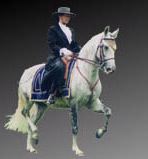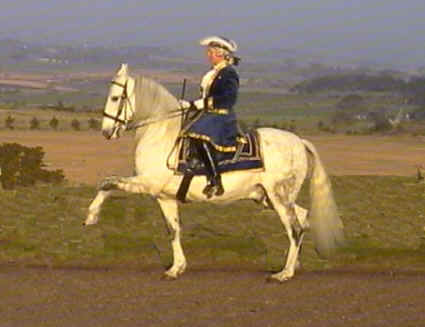 |
classicaldressagescotland.com |
| Classical dressage |
| New web address: www.classicaldressagescotland.com |  |
| About this site | About us | Personal Tuition | Video analysis | Lessons | Portugal and Lusitanos |
| Home Schooling Classical dressage Modern dressage Horse trials Show jumping Glossary Links |
When one thinks of Classical Equitation it
is easy for the mind to conjour images of current day practicioners
such as the Spanish Riding School of Vienna. It is truly a thrill
to see the skill, elegance and precision of their movements,
but it seems very far from what most people would seek to achieve,
or even consider that they might. In fact, it appears an archaic
form of horsemanship. It is entertaining and spectacular to watch,
and we may admire the way in which the horses have been trained
to respond and perform, but it seems to have little relevance
to what most people wish to do with their horses today. Certainly,
if you aspire to become a successful cross-country rider you
would be unlikely to begin your training by studying the classical
movements!
You would be more successful if you did! 
For thousand of years the horse was the pinnacle of transport. As well as being a mode of transportation for the wealthy, the horse's most demanding role was in warfare. Cavalry mounts had to be fit, supple, obedient and instantly responsive to the lightest of commands from the rider. If they were not, there might be no second chance. Not unsurprisingly, knowledge of how to train the horse for its role developed quickly and was refined over the years. Some of the specialist trainers wrote down their techniques and these were passed on for others to develop further. These specialists are referred to as the classical masters. They were interested in three things:
The horsey press is full of training articles which always begin by stressing the importance of good schoolwork and flatwork - but it is not as exciting as the jumping or cross country. At the highest levels of horsemanship, the need for athletic and obedience training is not skipped and many of the classical techniques are aspired to and their usefulness understood. But most people do not achieve (nor seek to achieve) the highest levels. Nor do they have access to the trainers who could allow them to develop their horses and their own skills. It is the intention of this website to allow you access to classical training and its benefits. We will simplify and explain the techniques and schooling practices used and allow you to see the benefits they would bring to both you and your horse. We do not intend to provide you with a history of Classical Riding, nor a review of the writings of the Classical Masters. There are many excellent books on these subjects. We will be more than happy to discuss these things with you if that is where your interest lies, but our main purpose with the website is to provide practical training and support to help you with your riding on a day-to-day basis. |